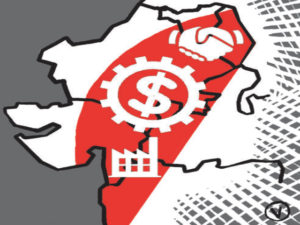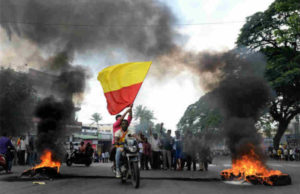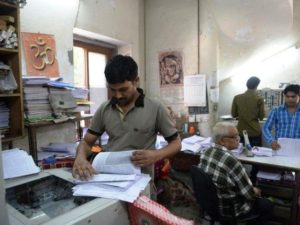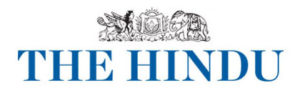
27-09-2016 (Important News Clippings)
A good call
Decision to ratify Paris climate accord will hold India in good stead

As the successor to the Kyoto Protocol, the Paris accord is the world’s last chance to pull itself away from the brink of climate catastrophe. It’s the world’s first extensive treaty to reduce greenhouse gases with both the US and China – the world’s two largest emitters – on board. However, for the agreement to be operationalised it needs a minimum of 55 nations, accounting for at least 55% of global emissions, to ratify it. Though more than 55 countries have already ratified the accord, hitherto they only account for 47.76% of global emissions. India’s ratification will push that figure much closer to the 55% threshold.It will also be recalled that India had unveiled an ambitious climate plan – also known as Intended Nationally Determined Contribution – as part of the Paris process. This included commitments to increase its non-fossil fuel power capacity to 40% by 2030. It also committed to reduce its emissions intensity per unit GDP by 33-35% below 2005 levels by 2030 and create an additional carbon sink of 2.5 to 3 billion tonnes of CO2 through afforestation. Much of this strategy rests on ramping up solar and wind power generation. But in light of the WTO ruling against India for imposing mandatory local content requirements on solar power developers, this is easier said than done.
That said, there are bigger obstacles to implementing the Paris accord further afield. For example, a Donald Trump presidency in the US could reverse the momentum in the climate change mitigation process even though technically Washington won’t be able to exit the treaty before four years from the time it achieves the ratification threshold. And that threshold could now be achieved even before the next annual climate change conference (COP 22) which begins in Marrakech on November 7. In any case, India has done well to announce its ratification decision early, for it will provide New Delhi the opportunity to play a crucial role in determining the Paris accord mechanisms. Climate change is an inescapable reality. India should serve as a facilitator for this crucial climate agreement.
Date:27-09-16
Right Medicine
Niti Aayog’s plan to replace MCI is just what the doctor ordered for medical education
MCI’s performance has been blighted by a fundamental conflict of interest. An election is held to allow the regulated to choose their regulators. From this basic flaw other problems follow, compounded by policymakers’ peculiar insistence on keeping education as a not-for-profit activity. This policy is a sham and merely encourages an underground economy in education. Niti Aayog has suggested a clean break from this by replacing MCI with a National Medical Commission which will be largely made up of members selected through a transparent process. This is an important step which will eliminate a basic flaw in the current regulatory structure.
Medical education in India and its subsequent impact on medical care has been adversely affected by MCI’s emphasis on infrastructure in colleges and not quality of students. Niti Aayog’s draft legislation wants to replace the current system with a common entrance exam as well as a common exit test to make sure doctors meet minimum standards prior to practice. It is important to end the vested interest medical colleges have in churning out substandard doctors. Both quality and quantity of doctors produced by the system need to be drastically enhanced, for which a version of the legislation proposed by Niti Aayog must be passed.
Get the biggest bang for our climate buck

While India has been steadfast about its commitment to the climate treaty, it was non-committal about the 2016 timeline championed, among others, by the US. As the third-largest emitter, accounting for 4.1 per cent of global greenhouse gas emissions, India was crucial to ensure the early entry into force for the Paris Agreement, which requires at least 55 countries accounting for at least 55 per cent of global emissions to formally join the treaty. For India, to use the opportunity to secure more predictable access to finance and technology, such as by becoming a member of the Nuclear Suppliers’ Group, to deal with climate change cannot be considered as unreasonable or a sign that it was being a laggard. Like any other country, India sought to leverage its position to secure other gains. Once the leverage ceased, India has shown the sense to change its tack.
The real problem for India was that its manoeuvring took place in the public glare. Often, senior representatives conveyed the impression that New Delhi was unwilling to do its bit to address a global challenge. India must realise the importance of balancing its pursuit of national interests with its role as a global player and that how a message is conveyed is central to the success of persuading others to its views. New Delhi will have the opportunity to apply its lessons when it negotiates the phase down of refrigerant gases such as hydrofluorocarbons (HFCs) in Kigali, Rwanda next month.
Date:27-09-16
The Delhi-Mumbai industrial stupor?

The developed world is awash with surplus savings and spare capacity. As ageing societies save ever more to fund their retirement and companies sit on trillions worth of cash they neither invest nor return to shareholders, the cost of capital declines, quite apart from the monetary policy innovations of central banks seeking to lift their economies out of secular stagnation. High-tech companies that can build mag-lev trains or plan a honeycomb road network for a city that will never get gridlocked sit twiddling nervous thumbs, without a place to deploy their wares/knowhow. At the same time, countries like India, growing fast and urbanising rapidly, desperately need modern, efficient infrastructure, ranging from brand new towns and low-cost renewable power to high-speed rail and road links and energy efficient buildings. What can bridge the gap between repressed supply and unmet demand are projects. Big ones, detailed, with worked out costs, time horizons, implementing structures, freed-up land and planning and regulation in place.It is the job of outfits like the Delhi Mumbai Infrastructure Corridor Development Corporation to produce those projects and associated clearances, plans and regulation. They should get on with it, not explain why snails give them an inferiority complex.
सिंधु नदी करार पर जल्दबाजी में कदम उठाना ठीक नहीं
जारी है शिक्षा की उपेक्षा
शिक्षा समाज की एक जरूरी किस्म की मानसिक खुराक हुआ करती है। शिक्षा के लाभार्थी सभी होते हैं। न केवल छात्र और अध्यापक, बल्कि पूरा का पूरा समाज इससे किसी न किसी रूप में जुड़ा होता है। शिक्षा से यह अपेक्षा होती है कि वह समाज की वर्तमान पीढ़ी को भविष्य में आने वाली चुनौतियों के लिए तैयार करे। वह सिर्फ विचार और कौशल ही नहीं देती, बल्कि सोच-विचार करने का तरीका भी मुहैया करती है। वह मस्तिष्क को भी प्रशिक्षित करती है। शिक्षित होकर समाज की आवश्यकता के अनुरूप कर्मी भी तैयार होते हैं। शैक्षिक अनुभव से मस्तिष्क परिवर्तित होता है और बदलती परिस्थिति के साथ ज्ञान का अनुकूलन होता है। ऐतिहासिक दृष्टि से देखें तो आधुनिक भारत में शिक्षा की यात्रा में कई पड़ाव और मोड़ आए हैं। औपनिवेशिक काल में स्थापित औपचारिक शिक्षा हमें एक खास तरह की बौद्धिक तैयारी के लिए आरंभ हुई थी। थोड़े बहुत हेर-फेर के साथ अभी भी उसी के नक्शे
कदम पर चल रहे हैं। एक कार्रवाई या कृत्य (रिचुअल) के रूप में उसकी खानापूरी हो रही है। उसकी समीक्षा, विमर्श और समाधान के प्रस्तावों के पुलिंदे धूल खा रहे हैं। शिक्षा के बिना समाज का काम नहीं चलने वाला है, पर अत्यंत महत्वपूर्ण होने पर भी पर शिक्षा पूरे राष्ट्रीय आयोजन में उपेक्षित क्षेत्र ही बना हुआ है। शिक्षा एक व्यापक व्यवस्था के अंग के रूप में जीविका और उसके द्वारा आवश्यकता पूर्ति का साधन भी है। साहित्य, संगीत और कला संस्कृति के हस्ताक्षर होते हैं। शिक्षा में इनके उपयोग से हमारा विस्तार होता है और रुचि के अनुसार विविधता का अवसर बनता है।
आज क्या सीखना चाहते हैं और क्यों सीखना चाहते हैं, इसका उत्तर आर्थिक उपलब्धि हो चली है। आज समाज कृषि से आगे चलकर उद्योग और सेवा के क्षेत्र की ओर आगे बढ़ रहा है। शिक्षा के बिना समाज का काम नहीं चलने वाला है। एक खास तरह के हस्तक्षेप के रूप में आज शिक्षा में जो बदलाव आएगा वह आगे के समाज का निर्माण करेगा। अच्छे गुणों को विकसित करना और बुरे को बाहर करना ही शिक्षा का ध्येय होता है। चुनने और छांटने का यह काम बचपन में जो सयाने लोग करते हैं उसे धीरे-धीरे बच्चा खुद करने लगता है, पर उम्र बढऩे के साथ कार्य की प्रकृति बदलने लगती है। सीखने के नए-नए उपाय इजाद होते रहे हैं। विद्यार्थी को आत्म-नियंत्रण और स्वाधीनता की सीख मिलती है। हम अपने बनाए नियमों और कानूनों से बंधने के लिए तैयार होते हैं। यह सब अमूर्त और मूर्त दोनों ही स्तरों पर होता है। भौतिक रूप में यह सब पहले समाज में घटित होता है। हम साझे के कामों द्वारा ऐसा करते हैं और फिर उसे आत्मसात कर लेते हैं। उसे उपयोग में लाकर हम उसके परिणामों का भी अनुभव करते हैं।
सीखने में व्यवहार के परिणाम का आगे होने वाले व्यवहार पर बड़ा गहरा असर पड़ता है। शिक्षा की प्रक्रिया से गुजर कर मनुष्य एक सक्रिय और स्वयं अपने नियामक का रूप ले लेता है। सभ्य समाज में कार्य की गुणवत्ता को पुरस्कृत करने का चलन है। व्यक्ति के माध्यम से हम ज्ञान और कर्म में आई विशिष्टता को पुरस्कृत करते हैं। पर व्यक्ति खुद को उसके साथ जोड़ लेता है और स्वयं को महत्वपूर्ण मानने लगता है। वह कर्म और कर्ता के अंतर को भूल जाता है। वह कर्म की विशिष्टता को अपने ऊपर आरोपित करने लगता है। सीखने का केंद्र कर्म से खिसक कर व्यक्ति के अंदर आने लगता है। व्यक्ति को अपने कर्म का अभिमान हो जाता है। वह भूल जाता है कि व्यक्ति तो कर्म का एक निमित्त है, उपकरण है जैसे और उपकरण या साधन होते हैं, फर्क यह है कि मनुष्य एक विशिष्ट उपकरण है। कर्म द्वारा अर्जित पुरस्कार को भ्रमवश वह स्वार्जित मान बैठने की भूल कर बैठता है। सीखने की क्रिया आंतरिक प्रेरणा द्वारा संचालित होनी चाहिए। सीखना एक संदर्भ में घटित होने वाली प्रक्रिया है। आज सीखने का भौतिक, सामाजिक और तकनीकी परिवेश बड़ी तेजी से बदल रहा है। शैक्षिक जीवन में शासकीय हस्तक्षेप की वृद्धि के साथ शिक्षा की स्वायत्तता घटती गई। इससे शिक्षा में शिथिलता आई। बाहर के भारी नियंत्रण के चलते आंतरिक शक्ति जाती रही। गुणवत्ता के नाम पर विदेशी मानकों की पुष्टि करना ही श्रेयस्कर माना गया। एक ढर्रे पर गुणा भाग कर किए शोध को वरीयता दी जाने लगी। उन्हीं के सिद्धांतों की परीक्षा, पुष्टि, परिवर्धन, विस्तार करना ही लक्ष्य बन गया। अर्थात यहां भारत में जो हो रहा है वह पश्चिम यानी यूरो-अमेरिकी देशों में जो हो रहा है उसका सीमित, कमजोर या अच्छा उदाहरण है। ज्ञान की उपयोगिता का प्रश्न ओझल हो जाता है।
अब तकनीक के तीव्र प्रवेश के साथ शिक्षा और ज्ञानार्जन के तौर तरीकों में कई बदलाव आ रहे हैं। वाचिक से लिखित होते हुए हम डिजिटल दुनिया की ओर आगे बढ़ रहे हैं। आज तमाम नए विषयों जैसे पर्यावरण, जीवन कौशल, मानव अधिकार, जेंडर आदि की शिक्षा देने पर बल दिया जा रहा है। अलग-अलग सूचनाओं के रूप में प्राप्त ज्ञान रटने या दोहराने के द्वारा मिलता है और ज्यादातर गैर सृजनात्मक होता है। वास्तविक ज्ञान सिद्धांत के उपयोग से ही उपजता है। दुर्भाग्य से प्रवेश, अध्ययन और परीक्षा की तकनीकी खानापूरी में हम शिक्षा के आशय को भूलते जा रहे है। उसकी गुणवत्ता दांव पर लग रही है। शिक्षा द्वारा ज्ञान का विस्तार एक पेचीदा और व्ययसाध्य उद्यम होता जा रहा है और हम हैं कि उसकी तरफ एक सरलीकृत कामचलाऊ नजरिये के आदी होते जा रहे हैं। समवर्ती सूची में होने के कारण भारत में जहां प्राथमिक और माध्यमिक स्तरों पर शिक्षा का आयोजन राष्ट्रीय या क्षेत्रीय स्तर की सरकारी योजना के तहत किया जाता है वहीं उच्च शिक्षा को विश्वविद्यालय के स्तर पर आयोजित किया जाता है। इनके सामाजिक-राजनीतिक संदर्भ अध्ययन की विषयवस्तु, शिक्षण के माध्यम और कार्य दशा को निर्धारित करते हैं। इन दृष्टियों से देश में भिन्नताएं हैं और विषमताएं भी। क्या छोड़ें और क्या पढ़ाएं? किसलिए पढ़ाएं? किसके लिए और कैसे पढ़ाएं? कौन पढ़ाए? ये राजनैतिक ही नहीं नैतिक प्रश्न भी हैं। शिक्षा सिर्फ सरकार की कारपोरेट सोशल रिस्पांसिबलिटी नहीं है। उसका एक मुख्य कार्य होना चाहिए। प्राथमिक से लेकर विश्वविद्यालय तक की शिक्षा के प्रयोजन और पद्धति पर गंभीर पुनर्विचार की आवश्यकता है।
[लेखक गिरीश्वर मिश्र, महात्मा गांधी हिंदी विश्वविद्यालय के कुलपति हैं ]
No feel for the pulse
The government has failed to provide the right incentives to farmers
In the fiscal year (FY) 2016, imports of pulses touched an unprecedented 5.8 million metric tonnes (MMT), against the domestic production of 16.5 MMT. Pulses production peaked in FY14, touching 19.25 MMT, but receded due to droughts in FY 2015 and FY 2016. This speaks of the failure of our strategy to achieve self-sufficiency in pulses.
Pulses attract government attention when inflation crosses the “tolerance limit”, as it did last year. Even in August 2016, retail inflation of pulses was 22 per cent. But in September, as moong started arriving in markets, its wholesale price crashed, in several markets, below its minimum support price (MSP). Such volatility hits both the farmers and consumers. One way of tackling such price volatility is to create a buffer stock of about 2 MMT of pulses, by procuring or importing when prices are low. This has been recommended several times; the latest recommendation has come from Arvind Subramanian’s report on pulses. It is heartening that the Union cabinet had already approved this limit for buffer stocking of pulses.
It may be worth revisiting the recent experience in creating buffer stocks to understand the operational challenges of the move, and how best to deal with them. The government decided to procure pulses in kharif 2015, when market prices were way above their MSPs. The operation was financed through a Price Stabilisation Fund (PSF) of Rs 500 crores created by the GoI. NAFED, SFAC and FCI were nominated as the nodal agencies for procurement, which in turn used state agencies like the Civil Supplies Corporation and State Cooperative Marketing Federation. These agencies do not have the track record, infrastructure and finances, necessary for procurement. They, with the help of state agencies, procured 50,422 tonnes of kharif pulses. Almost a year later, less than 10,000 tonnes have been disposed off. Most state governments have shown no interest in distributing pulses even though most of the subsidy is borne by the Centre, and retail prices have been high during this period. Given the short shelf-life of these pulses, usually less than a year, there is fear that a considerable part of the stocks would lose its quality.Given this experience, it is easy to fathom the challenge of procuring 2 MMT of pulses for buffer stocking. First, it would require a minimum working capital of Rs 10,000 crore — and not Rs 500 crore, as under PSF. The GoI should either set aside this amount in the budget or allow agencies like FCI to use its line of food credit for procuring pulses. NAFED will have difficulty in borrowing as its accounts have been frozen.
Second, as quality of pulses deteriorates fast, it would need better handling of procured amounts. Subramanian’s suggestion of creating a new agency that runs on public private partnership, may be worth trying, but private agencies cannot wait for years to get their reimbursements from the GoI, which happens routinely with state agencies like the FCI and NAFED. The latter still has an outstanding liability of Rs 1,083 crores on account of losses incurred in the procurement of chana, groundnut, copra and tur.
Third, if the economic cost of pulses (procurement price plus procurement incidentals, processing charges, stocking and distribution costs) to the state agencies is higher than the market prices, the buffer stocking operations of disposing pulses in the open market may end up in “losses” to the GoI; these are not taken very favourably by the Comptroller and Auditor General (CAG) of India. Unless these operations are treated as “subsidy” for price stabilisation operations, officials would be reluctant to run them for fear of CAG’s adverse comments.Above all, before the government enters the market to procure pulses, will it eliminate export bans and stocking limits on traders, delist pulses from the APMC Act, and review the Essential Commodities Act, 1955, as recommended by Subramanian report? Such restrictions on exports and stocking of pulses, reveal a pro-consumer bias. But with zero duty on imports, the restrictions are anti-farmer and they need to go. There is also a need for an import duty of about 10 per cent on pulses to make sure that the landed costs of imported pulses are not below MSPs. Else, the purpose of raising MSPs will be nullified. Will the GoI keep its promise to farmers to incentivise production of pulses?
Date:26-09-16
Change the course
Maximalist positions and court battles can’t help resolve festering inter-state river disputes.
The Cauvery resolution passed by the Karnataka assembly last Friday is a balancing act to calm a restive domestic constituency and address the Supreme Court, which has refused to accept the Siddaramaiah government’s plea that the state has no water to part with. The carefully-worded resolution, unanimously passed by the assembly, does not say the state will not follow the SC’s directive on water release. Instead, it points to the depleted storage in the Cauvery reservoirs and says that in the face of the acute distress the government can allow water to be drawn from the reservoirs only to meet “the drinking water requirements of the villages and towns in the Cauvery basin and the entire city of Bengaluru”. The Cauvery basin, of course, includes downstream Tamil Nadu, while water is sought by that state also for the current paddy crop. Karnataka, clearly, wants to separate the quantum of water necessary to meet household needs from that needed for irrigation purposes.
A nuanced approach is necessary to resolve the current stand-off. Though the Karnataka chief minister has said his government has no intention to disregard the orders of the court, it seems the state is most likely to ask for more time and a reduction in the quantum of water to be released downstream. State legislatures have in the past — Punjab and Karnataka in 2002, for instance — taken on the SC, causing a constitutional crisis. While, inter-state water-sharing disputes land in court after government-to-government talks fail, political parties must recognise that courts may not be the best place to resolve them. An enduring solution requires that there should not be a winner or a loser in a water dispute, which a court judgment is likely to result in. Governments will need to be sensitive to the other party’s claims and nuance their demands. Political parties will have to shun rhetoric and build consensus so that the needs of a river basin are met without compromising principles of equity.
Inter-state river water-sharing pacts are likely to be contested by the states in the basin for a variety of reasons. Historical usage patterns, reflecting the imbalance in the development of the basin, are likely to be questioned as less developed regions seek more water. Odisha and Chhattisgarh are now headed for a stand-off over the Mahanadi and tensions are on the rise in Karnataka and Goa over the Mahadayi waters. Parties and governments need to adopt reasonable positions on inter-state rivers and acknowledge their common stakes in enduring solutions.
बेजा प्रस्ताव

कावेरी जल विवाद पर सुप्रीम कोर्ट के फैसले के खिलाफ कर्नाटक बंद के दौरान कन्नड़ समर्थक कार्यकर्ताओं ने टायर जलाकर राष्ट्रीय राजमार्ग जाम कर दिया।
कर्नाटक विधानसभा ने बीते शुक्रवार को जो प्रस्ताव पारित किया वह बेहद अफसोसनाक है। सर्वसम्मति से पारित किए गए इस प्रस्ताव में तमिलनाडु को उसके हिस्से का कावेरी का पानी देने में असमर्थता जताई गई है। प्रस्ताव में भले सर्वोच्च अदालत के आदेश का उल्लेख नहीं है, पर यह साफ है कि विधानसभा का प्रस्ताव अदालत के फैसले की खुली अवमानना है। विडंबना यह है कि इस कृत्य में क्षेत्रीय पार्टियां ही नहीं, खुद के राष्ट्रीय होने का दम भरने वाली पार्टियां भी शामिल हैं। यह स्थिति तब है जब कर्नाटक को दिए जाने वाले पानी की मात्रा बाद के अपने आदेश के जरिए सर्वोच्च अदालत ने घटा दी। मगर कर्नाटक को वह भी गवारा नहीं है, तो इससे जाहिर है कि कावेरी के जल बंटवारे का मसला कितना नाजुक है।
पर इसके बावजूद इसे सुलझाना असंभव नहीं है। सबसे बड़ी समस्या यह है कि कावेरी का पानी दशकों से क्षेत्रीय भावनाएं भड़काने का मुद््दा बना हुआ है, इसलिए न्यायाधिकरण या अदालत के एक मौसमी या अंतरिम फैसले पर भी कावेरी के पानी में आग लग जाती है। कर्नाटक विधानसभा ने अपने प्रस्ताव में राज्य में पानी की कमी का हवाला दिया है। औसत से कम वर्षा के कारण कर्नाटक के इस तर्क को खारिज नहीं किया जा सकता। पर तमिलनाडु के कावेरी बेसिन के इलाकों की हालत तो और भी खराब है। दोनों तरफ के हजारों किसानों की आजीविका कावेरी के पानी पर निर्भर करती है। प्रस्ताव पारित करते समय कर्नाटक विधानसभा ने अपने पड़ोसी राज्य की जरूरत को क्यों ताक पर रख दिया? डर इस बात का है कि इसकी प्रतिक्रिया में कहीं कर्नाटक और तमिलनाडु के बीच एक बार फिर टकराव का दौर न शुरू हो जाए। अगर जल बंटवारे के विवाद को कावेरी बेसिन वाले राज्य आपसी सहमति से सुलझा लेते तो 2006 में कावेरी अवार्ड की जरूरत ही न पड़ती। लेकिन अवार्ड के भी निर्णय को दोनों राज्यों ने मानने से मना कर दिया और सुप्रीम कोर्ट में अपील की। अब अगर सर्वोच्च अदालत के भी फैसले को नहीं माना जाएगा, तो विवाद के निपटारे का क्या तरीका रह जाता है?
यों इस मामले में कर्नाटक अकेला उदाहरण नहीं है। छह महीने पहले पंजाब सरकार ने सतलुज-यमुना लिंक नहर का निर्माण न होने देने की घोषणा कर सर्वोच्च अदालत के फैसले को ठेंगा दिखाया था। ऐसे मामलों में संबंधित राज्य सरकारों को आखिरकार अदालत की फटकार सुननी पड़ी है और अपने कदम पीछे खींचने पड़े हैं। वर्ष 1991 में ही सर्वोच्च न्यायालय के पांच सदस्यीय पीठ ने साफ कर दिया था कि उसके फैसले को अध्यादेश या विधानसभा के प्रस्ताव के जरिए पलटा नहीं जा सकता। क्या सिद्धरमैया समेत कर्नाटक के सारे राजनीतिक सूरमा सुप्रीम कोर्ट के इस फैसले से अनजान हैं? कर्नाटक के हितैषी दिखने की सियासी होड़ में क्या वे यह सामान्य तकाजा भी नहीं समझते कि जो विवाद दूसरे राज्य से ताल्लुक रखता है उसके बारे में कर्नाटक विधानसभा एकतरफा निर्णय कैसे कर सकती है? पानी की कमी की सारी दुहाई के बावजूद बंगलुरु समेत कर्नाटक के शहरों में होने वाली पानी की बर्बादी के तथ्य दिए जा सकते हैं। चेन्नई से भी। अगर पानी को सहेजने का जतन हो, तो कावेरी विवाद का ऐसा हल निकाला जा सकता है जो टिकाऊ भी हो और बाकी देश के लिए प्रेरक भी।
दुष्परिणाम की फसल
इन दिनों सरसों की जीएम (जेनेटिकली मोडीफाइड) या जेनेरिक रूप से संवर्धित किस्म की खेती को स्वीकृति दिलवाने के प्रयास बहुत तेज हो रहे हैं। दूसरी ओर अनेक किसान संगठनों, पर्यावरण व खाद्य सुरक्षा संगठनों और वैज्ञानिकों ने इस ट्रांसजेनिक मस्र्टड हाईब्रिड डी एम एच-11 किस्म का जमकर विरोध किया है और इसके व्यापक दुष्परिणामों के विरुद्ध सरकार को बहुत विस्तृत ज्ञापन सौंपे हैं।यह बहस अब उतने ही संवेदनशील दौर में पहुंच गई है, जितनी कि पहले बीटी बैंगन की बहस पहुंची थी। उस समय विश्व की एक अति शक्तिशाली व साधन-संपन्न कंपनी ने न केवल अपनी पूरी ताकत बीटी बैंगन को स्वीकृति दिलवाने में लगा दी थी बल्कि विश्व के कुछ सबसे शक्तिशाली देशों के शीर्ष के नेताओं से अपने पक्ष में पैरवी भी करवा दी थी। तब की यूपीए सरकार में भी इन तत्वों के हितैषी मौजूद थे। तत्कालीन पर्यावरण मंत्री जयराम रमेश को इसका श्रेय है कि दबाव में आए बिना उन्होंने देश भर में सरकारी मान्यता प्राप्त जन-सुनवाइयों का आयोजन कराया, जिनमें खुले मंच पर वैज्ञानिकों, किसान संगठनों, पर्यावरण व जन-विज्ञान संस्थानों व सामाजिक कार्यकर्ताओं ने अपने विचार प्रकट किए। इसके अतिरिक्त, अनेक स्वतंत्र विशेषज्ञों द्वारा भेजी गई राय पर भी ध्यान दिया गया। इस व्यापक विमर्श से जो महत्त्वपूर्ण तय प्राप्त हुए, उनके आधार पर बीटी बैंगन पर रोक लगा दी गई। अब इस समय फिर यह जरूरत है कि व्यापक व खुले विमर्श द्वारा सरसों जैसी महत्त्वपूर्ण फसल में जीएम किस्मों व तकनीकों के खतरों के प्रवेश पर जानकारी व्यापक स्तर पर उपलब्ध हो। पर इस तरह के किसी विमर्श या आयोजन सरकार ने नहीं किया है। दूसरी ओर, निर्णय लेने की प्रक्रिया पर बड़े सवाल उठे हैं कि जिस जेनेटिक इंजीनियरिंग एप्रेजल कमेटी ने इस बारे में अहम निर्णय लेने हैं उनमें ऐसे वैज्ञानिकों को जगह दे दी गई है, जो स्वयं जीएम फसलों के विकास से और जीएम लॉबी के प्रयासों से जुड़े रहे हैं। ऐसे सदस्यों से स्वतंत्र व निष्पक्ष राय कैसे मिल सकती है? किसान संगठन प्राय: जीएम फसल के विरोध में आगे आए हैं, पर अब इन संगठनों का एक हिस्सा ऐसा भी है जो गुपचुप तरीके से बहुराष्ट्रीय खाद्य कंपनियों से सांठगांठ करना चाहते हैं। हालांकि जीएम सरसों के बारे में कहा जा रहा है कि इसे तो दिल्ली विविद्यालय से जुड़े कुछ वैज्ञानिकों ने विकसित किया है, पर यह पक्ष-विपक्ष दोनों को भली-भांति पता है कि असली खेल तो बहुराष्ट्रीय कंपनियों से जुड़े हितों के प्रसार का है। जीएम तकनीक विश्व की पांच-छह प्रमुख कंपनियों में केंद्रित है। अत: इनके प्रसार का फैसला या इनपर रोक न लगाने का फैसला तो अंत में उनको ही सबसे अधिक लाभ पहुंचाएगा। दरअसल, पहले बहुराष्ट्रीय कंपनियों व उनकी सहयोगी कंपनियों ने अपने द्वारा विकसित फसलों की किस्मों को ही फैलाने का प्रयास किया, पर इन बहुराष्ट्रीय कंपनियों के रिकार्ड से जुड़े अत्यधिक मुनाफे, खेती किसानी के नियंतण्रव भ्रष्टाचार के कारण लोग भड़क जाते थे। अत: अब एक दूसरा तरीका अपनाया जा रहा है कि अन्य वैज्ञानिकों द्वारा विकसत जीएम फसलों को पहले प्रवेश दिलवा दिया जाए। अत: इस समय मुद्दा केवल जीएम सरसों का नहीं है, बल्कि मुद्दा बहुत व्यापक है क्योंकि एक बार जीएम सरसों को प्रवेश मिल गया तो बहुराष्ट्रीय कंपनियों की बहुत सी जीएम खाद्य फसल भी इस आधार पर देश में प्रवेश पाने के लिए तैयार बैठी हैं। इस संदर्भ में इस ओर ध्यान दिलाना जरूरी है कि विश्व के सैकड़ों शीर्ष वैज्ञानिक स्वास्य, पर्यावरण व कृषि हितों की रक्षा के लिए जीएम फसल व तकनीक का बड़ा विरोध कर चुके हैं। इस विचार को इंडिपेंडेंट साइंस पैनल; स्वतंत्रता विज्ञान मंच ने बहुत सारगर्भित ढंग से व्यक्त किया है। इस पैनल में एकत्र हुए विश्व के अनेक देशों के प्रतिष्ठित वैज्ञानिकों व विशेषज्ञों ने जीएम फसल पर एक महत्त्वपूर्ण दस्तावेज तैयार किया, जिसके निष्कर्ष में उन्होंने कहा है-जीएम फसल के बारे में जिन लाभों का वायदा किया गया था, वे प्राप्त नहीं हुए हैं और यह खेतों में समस्याएं पैदा कर रहीं हैं। इन फसल का प्रसार होने पर ट्रांसजेनिक प्रदूषण से बचा नहीं जा सकता है। सबसे महत्त्वपूर्ण यह है कि जीएम फसल की सुरक्षा या सेफ्टी प्रमाणित नहीं हो सकी है। इन फसल की सुरक्षा संबंधी गंभीर चिंताओं के बावजूद यदि इनकी उपेक्षा की गई तो स्वास्य व पर्यावरण की क्षति होगी जिसकी पूर्ति नहीं हो सकती है, जिसे फिर ठीक नहीं दिया जा सकता है।
भारत डोगरा
On the right to photocopy
The DU photocopy judgment is a victory for access to education. But is it successful in balancing the competing interests of the academic community and the copyright holders?

BREAKTHROUGH: “The judgment will have a far-reaching impact inacademic circles as well as on the copyright industry.” File photo of the Rameshwari photocopy shop in New Delhi.
On September 16, the Delhi High Court dismissed the copyright infringement petition filed by three international publishers against a photocopy shop located in the Delhi University premises (The Chancellor, Masters and Scholars of the University of Oxford v. Rameshwari Photocopy Services). The court ruled that making course packs for suggested reading for students by photocopying portions of various prescribed reference books does not violate the copyright of the publishers.
Right to reproduction
Section 14 of the Copyright Act, 1957, grants a bundle of exclusive rights such as the right to reproduction on copyright owners for commercial exploitation of the work. Making photocopies amounts to reproduction. Photocopies made in violation of Section 14 thus constitute infringement unless it is listed under Section 52 as an act not constituting infringement. The judgment holds that if any provision of the Act permits any person other than the owner to reproduce any work or substantial part thereof, such reproduction will not amount to infringement (Para 27).The Copyright Act, to prevent stagnation of the growth of creativity, seeks to maintain a balance between the competing interests of the copyright owners on the one hand and the interests of the public to have access to works on the other. Copyright’s basic rationale is that there should be promotion of creativity through sufficient protection; and at the same time it also caters for dissemination of knowledge and access to copyright material through the doctrine of fair dealing. This doctrine, which is essential for research and academic purposes, is an exception to copyright holders’ exclusive rights. The Indian copyright law uses the term ‘fair deal’ (where listed purposes are statutorily embedded) whereas the U.S.’s copyright law adopts ‘fair use’ (which is merely illustrative). As per Article 13 of the Trade-Related Aspects of Intellectual Property Rights (TRIPS) agreement, these exceptions must confine to “special cases which do not conflict with a normal exploitation of the work and do not unreasonably prejudice the legitimate interests of the right holder”. Since the term ‘fair dealing’ is not defined in the Act, the judiciary determines its scope on a case by case basis.
Fair dealing
Section 52(1)(i) of the Copyright Act treats as fair dealing “the reproduction of any work (i) by a teacher or a pupil in the course of instruction; or (ii) as part of the questions to be answered in an exam; or (iii) in answers to such question. Section 52(1)(j) uses terms such as “staff and students of an educational institution” whereas Section 52(1)(i) uses “teacher or a pupil in the course of instruction.” On analysing this difference, the judgment holds that “there is no reason to interpret Section 52 (1)(i) as providing for an individual teacher and an individual pupil.” The word ‘instruction’ is not defined in the Act. According to Justice Rajiv Sahai Endlaw, the words “in the course of instruction” would include “reproduction of any work while the process of imparting instruction by the teacher and receiving instruction by the pupil continues during the entire academic session… imparting and receiving of instruction is not limited to personal interface between teacher and pupil but is a process commencing from the teacher readying herself/himself for imparting instruction, setting syllabus, prescribing text books, readings and ensuring, whether by interface in classroom/tutorials or otherwise…” Hence it would be fair dealing if the students click photographs of each page of portions of the prescribed book.
Limitations
Copyright must increase and not impede the harvest of knowledge. When the judgment reads, “Copyright is to motivate the creative activity of authors in order to benefit the public”, what is left for the copyright owners? The judgment places no limitation on photocopy if the material is prescribed in the course of instruction. Copyright holders invest considerably in creating works. Can this be ignored while interpreting Section 52(1)(i) as a license for reproducing unlimitedly everything prescribed in the suggested reading? If the legislature had intended to give such a wide interpretation to the words “in the course of instruction”, why does it add, “as part of the questions to be answered in an exam or in answers to such question” which should also be covered automatically? If the suggested reading provides for the whole book, does Section 52(1)(i) permit reproduction of the whole book or only reasonable excerpts? The judgment has conveniently avoided any direct reference to this aspect. The Court Commissioner had reported that “8 books were found being photocopied cover to cover”. Was the court successful in balancing the competing interests of the academic community and the copyright holders? When the university is entitled to free photocopy of 3,000 pages every month(Para 4), can the possibility of commercial interest be overruled? In that context, does it comply with Article 13 of TRIPS? Is it justified to cover the private photocopy shop in the university premises within the expression “in the course of instruction”? Doesn’t the judgment provide blanket immunity to the university to meet the demands of all the students by purchasing a single book?
Undoubtedly, the judgment, which is a breakthrough in the Indian copyright jurisprudence, is a major victory to access to education in a developing country like India. It will certainly have a far-reaching impact in academic circles as well as on the copyright industry. When access to education itself is a challenge, none of the students can be expected to purchase expensive textbooks, especially when syllabi prescribe certain portions from various books. Universities are expected to cater to students’ reading requirement without prejudicing copyright holders’ legitimate economic interests. Are the Indian universities honestly utilising funds earmarked for libraries for that purpose? The students’ demands can be met reasonably by permitting reproduction of reasonable excerpts.
S. Sivakumar is Professor at the Indian Law Institute, New Delhi, and former member, Copyright Board. Lisa P. Lukose is Associate Professor of Law, GGS Indraprastha University, Delhi. They are the authors of the book ‘Broadcasting Reproduction Right in India: Copyright and Neighbouring Rights Issues’.





